Novice English
In this triad of engaging activities, learners will explore compression patterns and ground deformation related to the Pacific Northwest subduction zone. Through hands-on models, data collection, and vector map analysis, students gain an understanding of how tectonic forces shape the region and the importance of earthquake preparedness.
In this 5-minute demonstration, learners use a giant compression spring (e.g., a pop-up laundry basket) to model ground movement in the Pacific Northwest, illustrating how the Juan de Fuca plate subducting beneath the North American plate causes varying motion across the region. By examining ground motion vectors on a map, they observe that coastal areas move the most, discuss the implications of the plate rebounding during an earthquake, and brainstorm earthquake preparedness strategies.
In this 30-minute activity, learners use a spring model to measure compression, observing how varying distances affect ground deformation and simulating tectonic plate movement. They then analyze a ground motion map of the Pacific Northwest, noting that coastal areas near the subducting Juan de Fuca plate move faster with longer vectors, while inland areas move slower with shorter vectors.
In this 60-minute activity, learners analyze a GPS vector map of Oregon and Washington, comparing plate velocities to understand why compression patterns vary inland and identifying regions with the highest seismic hazard. By modeling compressive forces with a minispring, watching a geomorphology video, and discussing earthquake preparedness strategies like ShakeAlert-powered alerts, they connect hands-on observations to real-world tectonic movement and seismic risk mitigation.
Through this series of activities, learners build a layered understanding of plate tectonics, ground deformation, and earthquake safety, helping them relate scientific concepts to real-world preparedness strategies.
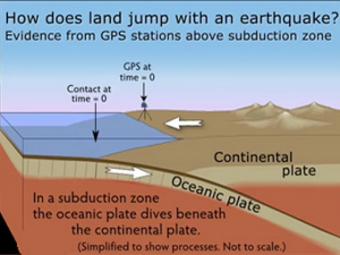
GPS can record the movement of the leading edge of the overlying continental plate in a subduction zone. The plates are locked and the overlying plate is forced back. When friction is overcome and strain is released, the GPS receiver will snap back toward its original position.
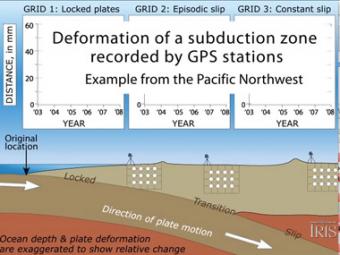
Subduction zones show that there are 3 distinct areas of movement in the overlying plate:
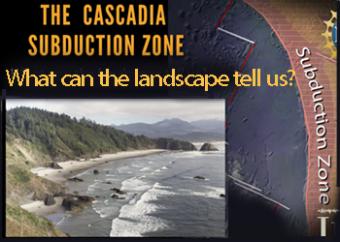
The Cascadia Subduction Zone of the Pacific Northwest is comprised of a collection of major geographic features, including the subducting plate, the subduction plate boundary, the Coast Range, the Puget-Willamette lowlands, and the Cascades Mountain Range.

In this activity, learners explore ground deformation at and near plate boundaries using hand and body motions, data from GPS and maps. In the 5-minute activity, learners explore the concept of vectors by kinesthetically enacting ground movement using their body and hand movements. In the 20-minute activity, learners model GPS ground motion in different regions and connect deformation to earthquake hazards. In the 45-minute activity learners distinguish between different boundary types by measuring the vectors within tectonic plates and identify regions with higher earthquake hazards, comparing their findings to earthquake shaking potential maps.
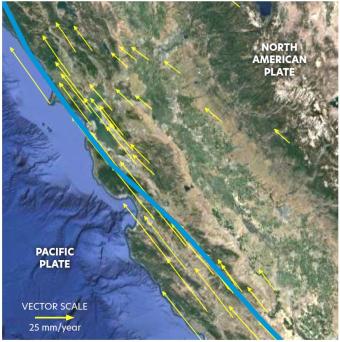
Tectonic plates are constantly moving, and GPS instruments help scientists measure this motion, identifying plate boundaries, deformation zones, and earthquake hazards, with rapidly changing regions being at higher seismic risk. This triad of activities engages learners in exploring authentic GPS data, using hand movements to model plate boundaries, creating vectors to analyze motion, and examining real-world GPS data to study deformation and earthquake risks in the western U.S. and Alaska. By interpreting data, role-playing geoscience careers, and learning about ShakeAlert, learners develop key skills in seismology, geodesy, and hazard preparedness while understanding the risks earthquakes pose to over 143 million people in the U.S.
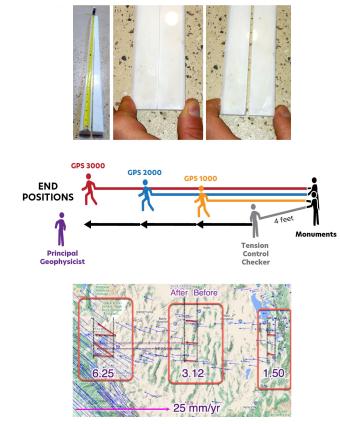
Ground deformation occurs both at plate boundaries and within plates, such as the Basin and Range Province in Nevada, Utah, and California, where extension and rifting can be measured using GPS data. This triad of activities helps learners explore deformation through hands-on modeling with marble tongs, kinesthetic demonstrations of extensional motion, and quantitative analysis of GPS vectors and earthquake hazard maps. Understanding these processes is crucial, as over 143 million people in the U.S. face earthquake risks, and tools like ShakeAlert use GPS data to provide early warnings that can help reduce damage and save lives.
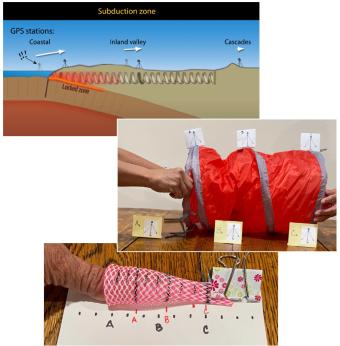
This set of hands-on activities helps students investigate ground deformation and earthquake hazards in the Pacific Northwest using physical models, real-world data, and map analysis. A brief demonstration with a compression spring illustrates how the subduction of the Juan de Fuca plate beneath the North American plate causes varying motion across the region. In longer activities, students measure compression, analyze GPS vector maps, and identify seismic hazard zones. By interpreting real-world data, students develop a deeper understanding of tectonic forces and connect these concepts to earthquake preparedness strategies.
We encourage the reuse and dissemination of the material on this site as long as attribution is retained. To this end the material on this site, unless otherwise noted, is offered under Creative Commons Attribution (CC BY 4.0) license